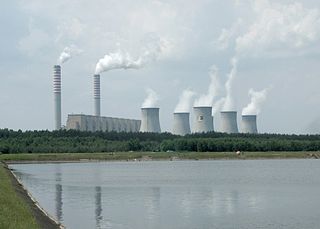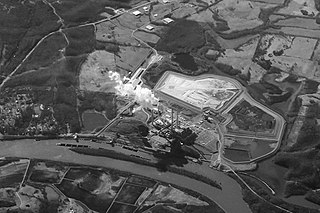
Electricity generation is the process of generating electric power from sources of primary energy. For utilities in the electric power industry, it is the stage prior to its delivery to end users or its storage, using for example, the pumped-storage method.
Puget Sound Energy, Inc. (PSE) is an energy utility company based in the U.S. state of Washington that provides electrical power and natural gas to the Puget Sound region. The utility serves electricity to more than 1.2 million customers in Island, King, Kitsap, Kittitas, Pierce, Skagit, Thurston, and Whatcom counties, and provides natural gas to 877,000 customers in King, Kittitas, Lewis, Pierce, Snohomish and Thurston counties. The company's electric and natural gas service area spans 6,000 square miles (16,000 km2).

Jeffrey Energy Center is a sub-bituminous coal-fired power plant located in Emmett Township, Pottawatomie County, seven miles (11 km) northwest of St. Marys, Kansas. Jeffrey EC is jointly owned by Westar Energy and Aquila Corp., both wholly owned subsidiaries of Evergy, Inc., Kansas City, Missouri. Jeffrey EC is composed of three separate 800-MW units providing a name-plate energy center capacity of 2.16 gigawatts. Unit 1 began operation in 1978, unit 2 in 1980 and unit 3 in 1983.

A fossil fuel power station is a thermal power station which burns a fossil fuel, such as coal, oil, or natural gas, to produce electricity. Fossil fuel power stations have machinery to convert the heat energy of combustion into mechanical energy, which then operates an electrical generator. The prime mover may be a steam turbine, a gas turbine or, in small plants, a reciprocating gas engine. All plants use the energy extracted from the expansion of a hot gas, either steam or combustion gases. Although different energy conversion methods exist, all thermal power station conversion methods have their efficiency limited by the Carnot efficiency and therefore produce waste heat.

Homer City Generating Station is a decommissioned 2-GW coal-burning power station near Homer City, in Indiana County, Pennsylvania, USA. It is owned by hedge funds and private equity firms and is operated by NRG Energy. Units 1 and 2, rated at 660 MWe, began operation in 1969. Unit 3, rated at 692 MWe nameplate capacity, was launched in 1977. It employed about 124 people.

Cumberland Fossil Plant is a pulverized coal-fired power station located west of Cumberland City, Tennessee, US, on the south bank of Lake Barkley on the Cumberland River. Owned and operated by Tennessee Valley Authority (TVA), it has a gross capacity of 2,470 MW, and is the most powerful power station in Tennessee.

The Conemaugh Generating Station is a 1,872 MW baseload coal-powered plant located on 1,750 acres (710 ha), across the Conemaugh River from New Florence in Western Pennsylvania. Track 3 of the Norfolk Southern Pittsburgh line runs next to the power plant.

Peterhead Power Station is a multi-unit station owned and operated by SSE plc, with a capacity of 2,177 MW. It is located near Boddam and the A90, just south of Peterhead, in Aberdeenshire, in the northeast of Scotland. It stands next to Sandford Lodge, a circa-1800-built structure. Initially operating as an oil-fired power station and later transitioning to fossil gas, the plant has also served as a site for experimental hydrogen generation capacity.

Bull Run Fossil Plant, commonly known as Bull Run Steam Plant, is a retired 889 megawatt (MW), coal-fired electric generating station owned and operated by the Tennessee Valley Authority (TVA). The plant is the only coal fired power plant ever constructed by TVA with one unit, and was retired on December 1, 2023.

Coal generated about 19.5% of the electricity at utility-scale facilities in the United States in 2022, down from 38.6% in 2014 and 51% in 2001. In 2021, coal supplied 9.5 quadrillion British thermal units (2,800 TWh) of primary energy to electric power plants, which made up 90% of coal's contribution to U.S. energy supply. Utilities buy more than 90% of the coal consumed in the United States. There were over 200 coal powered units across the United States in 2024. Coal plants have been closing since the 2010s due to cheaper and cleaner natural gas and renewables. Due to measures such as scrubbers air pollution from the plants kills far fewer people nowadays, but deaths in 2020 from PM25 have been estimated at 1600. Environmentalists say that political action is needed to close them faster, to also reduce greenhouse gas emissions by the United States and better limit climate change.

The Dickerson Generating Station is an 853 MW electric generating plant owned by NRG Energy, located approximately two miles west of Dickerson, Maryland, on the eastern banks of the Potomac River.

The Chalk Point Generating Station is an electricity-generating plant, comprising oil and natural gas fired units, owned by NRG Energy, located near the town of Eagle Harbor, Maryland, United States, on the Patuxent River.

The Saint Clair Power Plant was a major coal- and oil-fired power plant owned by DTE Electric, a subsidiary of DTE Energy. It was located in St. Clair County, Michigan, on the west bank of St. Clair River. The plant was across M-29 from the newer Belle River Power Plant in East China, Michigan. The first four units of St. Clair were built in 1953–1954. Since then, three more generating units were added to the plant. The St. Clair Power Plant generated 1982 megawatts in total. It was Detroit Edison's second largest power producer. The power plant has a large impact on the local economy, employing about 300 workers. The plant shut down in May 2022.

Keadby Power Stations are a pair of natural gas-fired power stations near Scunthorpe in North Lincolnshire, built on the site of an older coal power station. The site lies near the B1392 and the River Trent, and the Scunthorpe-Grimsby railway. Also nearby is the Stainforth and Keadby Canal, which is part of the Sheffield and South Yorkshire Navigation. The current stations are operated by SSE Thermal.

Little Barford Power Station is a combined cycle gas turbine power station in the village of Little Barford in Bedfordshire, England. It lies just south of the A428 St Neots bypass and east of the Wyboston Leisure Park. The River Great Ouse runs alongside. It was formerly the site of two coal-fired power stations, now demolished. The station is operated by RWE.

Centralia Big Hanaford power plant is a coal-fired power plant supplemented with natural-gas-fired units. It is located east of Centralia, Washington, United States in Lewis County. It is the only commercial coal-fired power plant in the State of Washington.
Warrick Generating Station is a 755-MWe coal-fired electricity-generating station, located southeast of Newburgh in Warrick County. It sits on the north bank of Ohio River, downstream of the F. B. Culley Generating Station. The plant has four coal-fired, steam-powered turbines with a combined generating capacity of 791 MWe. Alcoa owns three of the four generating stations, which were placed into service in the early 1960s. The largest unit, known as Unit 4, is 323-MWe unit jointly owned by Alcoa and Vectren. This larger unit was placed in operation in 1970.

Brunner Island Steam Electric Station is a coal-fired, alternatively natural gas-powered electrical generation facility in York County, Pennsylvania. It occupies most of the area of the eponymous island on Susquehanna River. The power plant has three major units, which came online in 1961, 1965, and 1969, with respective generating capacities of 334 MW, 390 MW, and 759 MW. In addition, three internal combustion generators were installed in 1967. Talen Energy will stop coal use at the plant in 2028.

The W.A. Parish Generating Station is a 3.65-gigawatt, dual-fired power plant located near Thompsons, Texas. The station occupies a 4,664-acre site near Smithers Lake southwest of Houston in Fort Bend County and consists of two four-unit plants; one natural gas and the other coal. With a total installed capacity of 3,653 MW, it is the second largest conventional power station in the US, and supplies about fifteen percent of the energy in the Houston area. NRG Energy owns and operates the plant.

James H. Miller Jr. Electric Generating Plant, also known as Miller Steam Plant or Plant Miller, is a coal-fired electrical generation facility sitting on approximately 800 acres (320 ha) in West Jefferson, Alabama. It is owned by Alabama Power, a subsidiary of Southern Company.



















